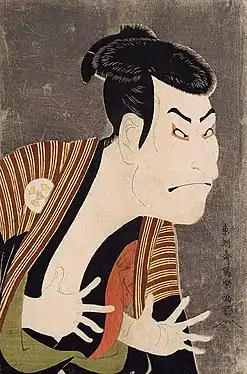Hashira-e
Hashira-e (柱絵) or Pillar prints are Japanese woodblock prints usually measuring about 4.5 by 28 inches.

They were originally intended to be hung upon, or pasted onto, wooden pillars inside Japanese houses. They probably served as cheap alternatives to hanging scrolls (kakemono) which were typically made of silk.[1] Okumura Masanobu (1686–1764) is credited with popularizing this format of print. They were popular during the second half of the eighteenth century.[2] Surviving examples are rare, and those that do are often faded, worn, or stained from exposure to soot and smoke.[1]
Ukiyo-e artist Koryūsai (1735–1790) designed many hashira-e depicting a wide variety of subjects, particularly gods and beautiful women (bijin-ga).[1] The popularity of hashira format prints began to wane around 1800 and they were superseded by replaced by vertical diptychs of the larger oban format which offered greater compositional freedom for the artist.[2]
Gallery
 Lovers' Tryst, Koryūsai
Lovers' Tryst, Koryūsai_-_Suzuki_Harunobu.jpg.webp) Two Lovers in Snow beneath Umbrella, Suzuki Harunobu
Two Lovers in Snow beneath Umbrella, Suzuki Harunobu General Yu (left: ishizuri-e - right: normal version, Katsukawa Shunshō
General Yu (left: ishizuri-e - right: normal version, Katsukawa Shunshō Oshichi and Kichisaburo, Kitigawa Utamaro
Oshichi and Kichisaburo, Kitigawa Utamaro
References
![]() Media related to Hashira-e at Wikimedia Commons
Media related to Hashira-e at Wikimedia Commons
- Hockley, Allen (2003). The Prints of Isoda Koryūsai: Floating World Culture and Its Consumers in Eighteenth-century Japan. University of Washington Press.
- Dieter Wanczura. "What are Hashira-e?". Artelino. Retrieved 1 November 2020.
Further reading
- Pins, Jacob (1982). The Japanese Pillar Print: Hashira-e. Sawers.
- Hashira-e: Pillar Prints from the Jacob Pins Collection and the Museum Collection. Tikotin Museum of Japanese Art. 1987.
